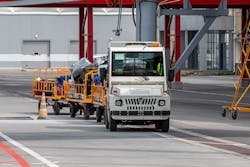Baggage handling challenges demand new solutions
Fort Atkinson, Wis., - The demand for air travel in 2022 far exceeded the aviation industry’s expectations and the trend has continued in 2023. The industry estimated that 3.42 billion passengers traveled in 2022.
While that is a positive development, it has not been without its challenges. Most notably, the persistent labor shortages in conjunction with increasing demand have caused many airlines to cancel flights to the disappointment of passengers, Michael Reinkober writes for AviationPros. Continue reading original article.
The Military & Aerospace Electronics take:
23 October 2023 - Advanced baggage handling optimization software takes a more holistic approach towards improving these processes. It tackles the problem of mishandled or lost baggage by providing critical information pertaining to passengers and their baggage connections in advance so that any potential problems can be resolved prior to an aircraft’s landing. The software evaluates high priority flights and passenger connections in conjunction with key performance indicators (KPIs), cost to benefit ratios, and passenger notification.
The goal is to avoid preventable disruptions. It automatically updates information from flight information systems, booking systems, and flight departure control systems. All staff involved in baggage transfers from dispatchers to drivers are supported along with such tasks as the dispatch of agents for short and missed connections. Dashboard updates and other reports deliver valuable data relating to support optimal decision-making and operational efficiency.
Where transfer baggage is concerned, the software maximizes the possible tail-to-tail baggage transfers, taking into account all available resources and the current workload. Baggage managers can set a time corridor for the so-called cut-off time, which determines up to which connection time bags will be transported tail-to-tail. The software automatically maximizes the tail-to-tail connections within the given time corridor. This advanced functionality is already being tested by leading airlines.
Related: Amsterdam airport to fast-track the use of baggage robots
Related: Schiphol tests new tech to lighten physical work in baggage handling
Related: Fraport tests autonomous baggage and cargo tractor
Jamie Whitney, Senior Editor
Military + Aerospace Electronics
